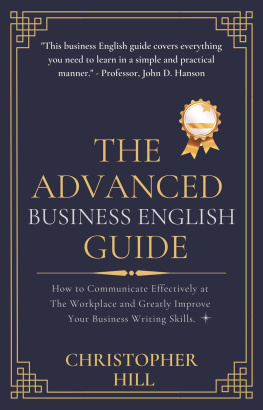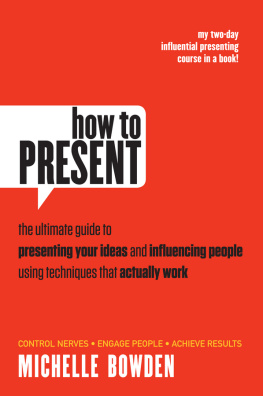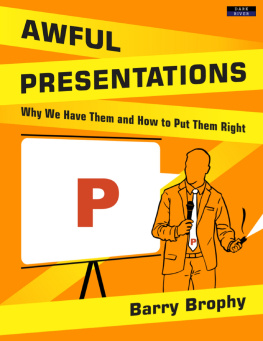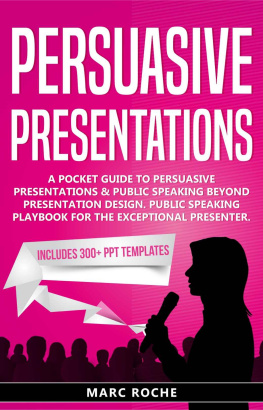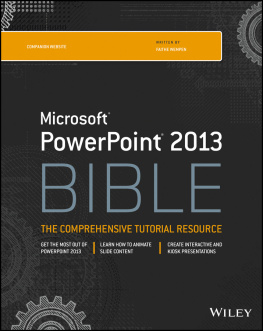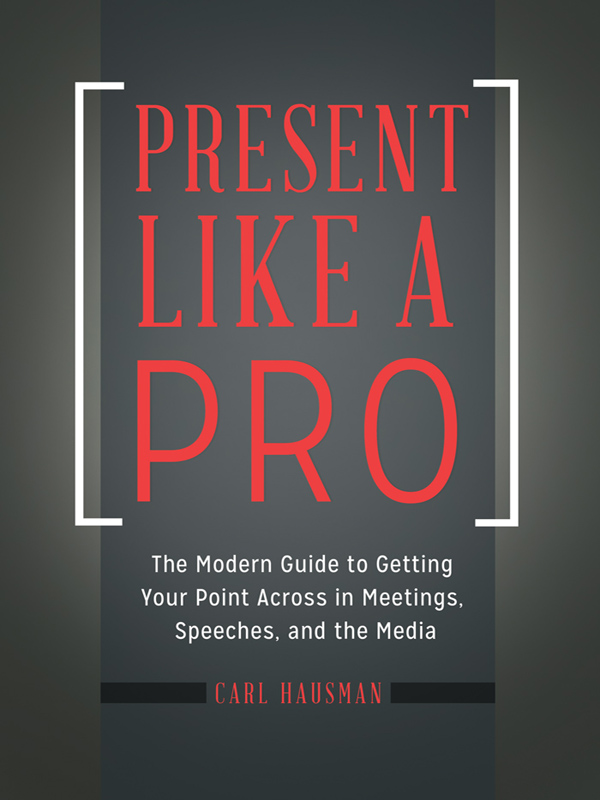Present Like a Pro
Copyright 2017 by Carl Hausman
All rights reserved. No part of this publication may be reproduced, stored in a retrieval system, or transmitted, in any form or by any means, electronic, mechanical, photocopying, recording, or otherwise, except for the inclusion of brief quotations in a review, without prior permission in writing from the publisher.
Library of Congress Cataloging-in-Publication Data
Names: Hausman, Carl, 1953- author.
Title: Present like a pro : the modern guide to getting your point across in meetings, speeches, and the media / Carl Hausman.
Description: Santa Barbara, California : Praeger, [2017] | Includes bibliographical references and index.
Identifiers: LCCN 2016042048 (print) | LCCN 2016056962 (ebook) | ISBN 9781440853289 (hardcopy : alk. paper) | ISBN 9781440853661 (pbk. : alk. paper) | ISBN 9781440853296 (eBook)
Subjects: LCSH: Business presentations. | Public speaking. | Business communication. | Public relations.
Classification: LCC HF5718.22 .H39 2017 (print) | LCC HF5718.22 (ebook) | DDC 658.4/52dc23
LC record available at https://lccn.loc.gov/2016042048
ISBN: 978-1-4408-5328-9 (hardcover)
ISBN: 978-1-4408-5366-1 (paperback)
EISBN: 978-1-4408-5329-6
212019181712345
This book is also available as an eBook.
Praeger
An Imprint of ABC-CLIO, LLC
ABC-CLIO, LLC
130 Cremona Drive, P.O. Box 1911
Santa Barbara, California 93116-1911
www.abc-clio.com
This book is printed on acid-free paper 
Manufactured in the United States of America
Contents
Thank you for reading this book, and while it really needs no introduction, without further ado let me YOURE ALREADY ZONED OUT, ARENT YOU?
Of course you are. I began with three droning clichs, which of course led you to believe that you were being served up yet another bland and indifferent word salad, presented timidly and tepidlyin other words, the standard fare served up by most people who are compelled to give a presentation without the proper training.
It doesnt have to be this way. I can teach you how to become an excellent presenter, and I can do it by showing you 10 basic techniques, each broken down into 10 digestible and easily enacted steps.
There is nothing gimmicky or superficial about this approach. All skills involve learning and applying technique, one step at a time. But many people called upon to present have been given no explicit guidance, orworse, perhapshave been subjected to instruction from books and seminars that are long on theory about getting your point across but short on clear direction on exactly how to do it.
Present Like a Pro does tell you precisely how to:
Plan a presentation (using standard formulas you probably didnt even know existed),
Galvanize attention with powerful opens and closes,
Handle tough crowds,
Develop a powerful speaking voice,
Deftly employ presentation technology,
Use humor effectively and without risk, and
Not only overcome stage fright but also use it to your advantage.
I also provide you with some templates for common presentations and show many examples of how and why presentations motivate, inform, and persuade.
And, as a bonus, Present Like a Pro shows you how to be a pioneer in a trend that increasingly dominates the world of business and professional presentation: appearing and presenting on media in interviews, YouTube videos, podcasts, and audiobooks. Moreover, I demonstrate how new digital media can allow you to create something of a small-scale personal media empire, and how to use the synergy of your media to not only bolster public recognition but possibly move you into the realm of professional speaking.
I know how to show you all of this because Ive done it, and I know how to teach it because Ive done that, too. Ive made my living as a lecturer, professor, and writer, with more than ten books about communication skills under my byline. Ive appeared on network TV, testified before Congress, worked on-air in television and radio, and narrated several audiobooks.
Before you begin with the first of the 10 techniques, let me address my seeming obsession with the number 10. Ive become convinced that humans are hardwired to think and absorb in increments of 10. Maybe its because of that 10-finger thingwhich, after all, did give birth to our entire number system and the digital universe (digit means finger, by the way). I dont view it as a coincidence that there are 10 Commandments, 10 amendments to the Bill of Rights, and tens of millions of top-10 lists everywhere on the Internet, and that the dean of a college gets that title from a Latin word that means leader of 10, the same root that provides us with the English words decade and deacon. (The Romans were really hung up on units of 10 and based their social and military order on it, so if Im obsessive, at least I have historical precedent.)
But I think Ill win you over if you take a look at the table of contents. Youll see how each chapter and step provides just enough information to give you a complete picture of what youll be doing, but not so much that you get lost in the weeds.
Everything is useful, and everything is calculated to help you move forward one step at a time and to reinforce previous learning.
And last but not least, let me take this opportunity to reinforce the fact that you should never use clichs like last but not least.
You are free to access the material in any order you wantafter all, its your book. You paid for it. Thanks, by the way. But I humbly recommend that you read it straight through.
Theres an underlying strategy to the order of the techniques and steps: They are arranged in a need-to-know basis, meaning that the most basic and helpful material is presented first, and everything builds in sequence.
Ive tried to keep cross-referencing to a minimum because it can be distracting, but its necessary in cases where relevant information has been or will be presented. References to other chapters will cite both the chapter and step, such as See , Step 4, but references to numbered steps within the same chapter will include only the step number: See Step 4.
Throughout the book I provide as many examples as reasonable without breaking up the flow of the narrative. Youll find longer examples of the principles in action in , where I take a mixture of outstanding presentations, some newer, some classic, and point out the techniques used in their planning and execution.
With that in mind, lets begin at the logical first step: How to plan what youre going to say...
I did not intend to inflict upon you Ben Franklins bromide about how those who fail to plan, plan to fail, but I cant avoid it.
So there.
Having dispensed with that obligation, let me stress that planning a presentation does not have to be an intricate or tedious process. Follow the steps in this chapter, and you can draw up a plan in just a few minutes. Your blueprint can incorporate strategies that have proven effective for centuriesI mean that literallyand can save you stress, tedium, false starts, and embarrassment.
Almost any plan is better than no plan. Plans dont have to be complex.
Your plan can be as simple as beginning, middle, and end. That was good enough for Aristotle, and he did okay in the presentation department, Ive been told. The most famous orator in history, Cicero, advocated a grand total of six parts to a presentation: an introduction, a summary statement of the case you are trying to make, major points in your case, refuting opposing points, crowing about how you have just refuted those points, and a conclusion in which you show how you have made your case.


